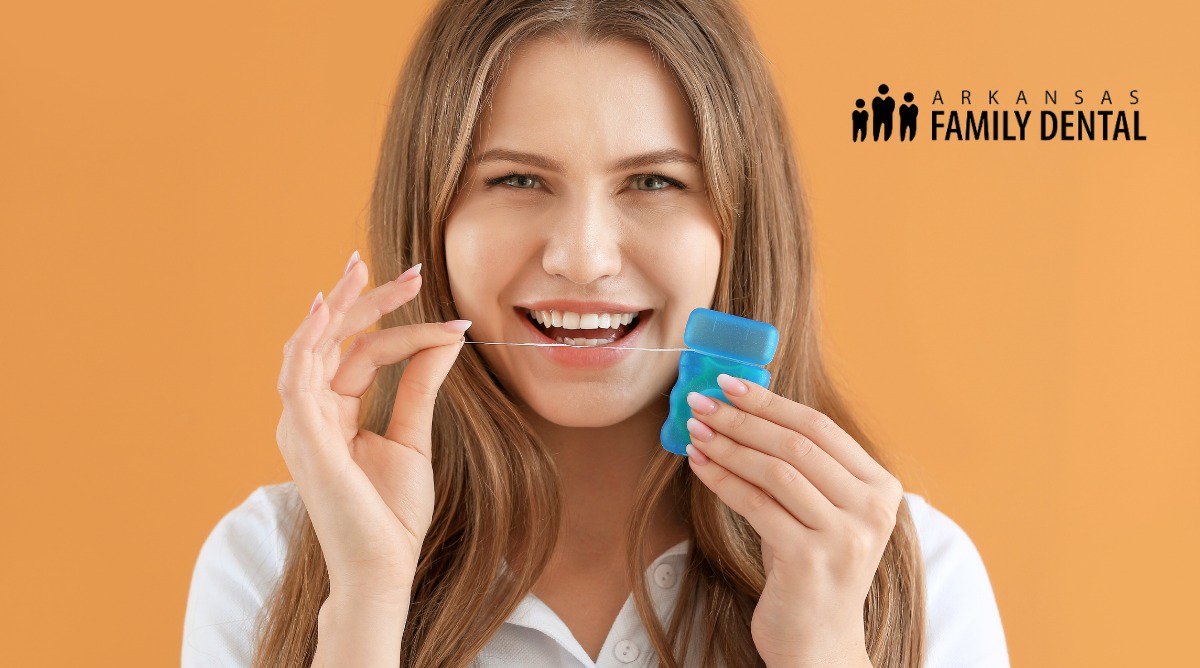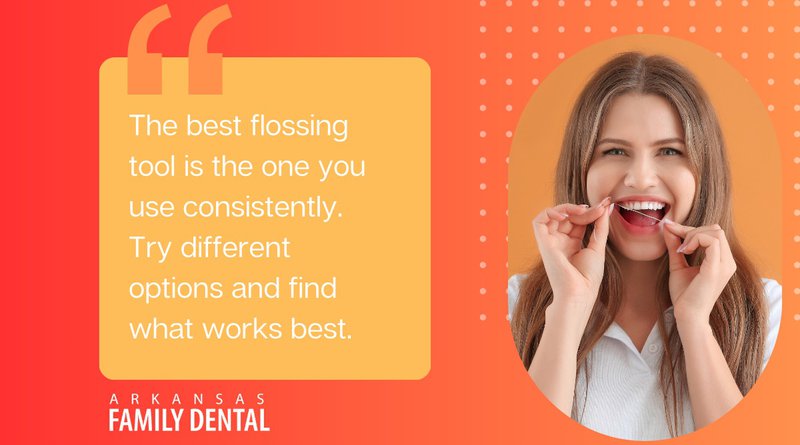Discover the Best Flossing Tools for You

March 27, 2025
Flossing is essential for your healthy smile, but with so many options, which tool is best for you? Should you stick with traditional floss, try a water flosser, or use floss picks? The right choice depends on your teeth, gums, and lifestyle. This guide breaks down the best flossing tools, their benefits, and which one suits your needs. Read on to find tools to keep your smile clean and healthy!
Key Takeaways:
- Traditional Floss: Removes plaque effectively but can be tricky for tight teeth or those with limited dexterity. Waxed floss slides more easily, while unwaxed offers a better grip.
- Floss Picks: Convenient and easy to use but may not clean as thoroughly as string floss and can transfer bacteria.
- Water Flossers: Good for those with braces, implants, or gum issues. They are gentle on gums but may not clean tight spaces as well as floss. Dentists often recommend using both.
- Best for Braces: Floss threaders help navigate underwires, while water flossers clean around brackets. A combination works best.
- Best for Tight Teeth: Ultra-thin or waxed floss prevents shredding. PTFE floss, like Glide, works well.
- Sensitive Gums: Waxed, soft, or expanding floss minimizes irritation. A water flosser is a gentle alternative.
- Limited Mobility (Seniors/Arthritis): Water flossers, floss holders, and pre-threaded picks make flossing easier.

Best Flossing Tools Available
Traditional Dental Floss: Pros and Cons
The best flossing tools, like traditional dental floss, are a simple and effective way for you to clean between your teeth. It removes plaque and food particles, helping prevent cavities and gum disease. Maintaining this habit daily is a key part of your oral health, according to the American Dental Association.
One major benefit of traditional floss is you guide the movements, ensuring a thorough cleaning. The best flossing tools in this category include waxed, unwaxed, and flavored options. Waxed floss slides easily between teeth, while unwaxed floss provides a firmer grip.
However, if your teeth are tightly spaced, string floss might be challenging to use for those with limited dexterity. If flossing is painful or difficult, consider other methods.
Floss Picks vs. Dental Floss:
Floss picks are small, plastic tools with a short piece of floss between two prongs. Their biggest advantage is convenience. They can be used with one hand, making flossing easier for you.
While traditional floss offers better control and provides a clean section for each tooth, floss picks are perfect for ease of use. If you’re looking for the best flossing tools for convenience, floss picks are a great choice.
Water Flossers vs. Traditional Flossing
Also known as oral irrigators, water flossers use a stream of water to remove plaque and debris. They are especially helpful if you have braces, implants, or gum disease. A major benefit of water flossers is they are easy to use if you have arthritis or mobility issues.
However, water flossers take up more space and can be pricey. Some models need power or frequent refills. Also, they may not clean tight spaces as well as string floss. Many dentists recommend using both water flossers and traditional floss for the best results.
Using Water Flossers
Benefits of Using a Water Flosser
A water flosser, one of the best flossing tools, directs a steady stream of water between your teeth and along your gums. This helps remove plaque and food particles from hard-to-reach areas. If you have braces, implants, or gum concerns, you may find water flossers easier to use than traditional floss.
Studies show that water flossers effectively reduce plaque and gingivitis. They clean below the gumline, where bacteria tend to gather, and can also stimulate circulation in your gums, promoting overall health. If you experience discomfort while flossing, a water flosser may be a great alternative.
How to Use a Water Flosser Correctly
To get the most out of your water flosser, fill the reservoir with warm water and select a comfortable pressure setting. Make sure to place the tip in your mouth before turning it on to avoid splashing. Aim the stream at your gumline and move it along each tooth, paying attention to the spaces between teeth and around any dental work. Spend at least one minute covering all areas.
If you have sensitive gums, start with a low-pressure setting. Some models even come with specialized tips for braces, implants, or deep cleaning, making them versatile for different needs.
Best Water Flossers for Different Needs
Cordless models are perfect for travel or small bathrooms, while rechargeable options can last weeks without needing a charge. The most effective water flossers for plaque removal include adjustable pressure settings and various tip options. If you have a family, look for models that come with multiple tips and larger reservoirs.
For those with braces, orthodontic tips are designed to help clear particles stuck around brackets and wires. By choosing the right model, you’ll make dental care easier and more effective.
Flossing With Braces and Orthodontic Devices
Flossing with braces can be challenging, but using the best flossing tools makes it much easier. Standard floss alone is often insufficient, so finding the right tool is essential for a thorough clean.
Floss Threaders: How They Work for Braces
A floss threader is one of the best flossing tools for braces. It’s a flexible plastic loop that helps guide the floss under your wires. To use it, simply insert the floss through the loop, slide the threader beneath the wire, and pull the floss through. Then, floss as usual. Threaders work well but can take time, as you’ll need to repeat the process for each tooth.
Best Flossing Technique for Braces
For the best results, thread the floss under the wire, then slide it between two teeth. Move it up and down against each side carefully, but be sure to avoid snapping it against your gums. Pre-threaded flossers designed for braces have a thin arm that fits under wires, making the process easier for you.
This Guide offers more flossing tips for braces.
Water Flosser vs. Floss Threader for Orthodontic Care
One of the best flossing tools for braces is a water flosser. It directs pressurized water around your brackets, helping to remove trapped debris. In fact, the Mayo Clinic notes that water flossers can reach areas that regular floss might miss. Additionally, water flossers are faster and cause less irritation compared to traditional flossing methods. On the other hand, floss threaders provide a deeper clean between your teeth, effectively targeting areas that are harder to reach.
For the best approach, consider using both tools: start with a threader to clean between your teeth and finish with a water flosser to ensure a complete clean.
Best Flossing Tools for Seniors and Limited Mobility
Easier Flossing Tools for Seniors
As a senior, you may experience difficulty flossing due to reduced grip strength, but don’t worry—the right tool can simplify the process. One of the best flossing tools for you is a water flosser. Many models feature easy-grip handles with large buttons, making them more user-friendly. Additionally, floss holders are a great option as they secure the floss, eliminating the need to wrap it around your fingers. Extra-long handles can further improve reach, allowing you to floss comfortably. Pre-threaded floss picks are another excellent choice, requiring minimal effort and making flossing even easier for you.
Best Floss Aids for Arthritis
If you have arthritis, you may struggle with traditional floss, but there are great alternatives to consider. Dental floss holders provide better control and require less grip strength, which makes flossing more manageable. Some models also feature angled heads, helping you access your back teeth more easily. Electric flossers with vibrating tips are another option—they reduce hand strain while providing an effective clean. For an even more arthritis-friendly experience, water flossers with ergonomic designs and large control buttons can make flossing effortless.
How Floss Holders Help
Floss holders are indeed helpful, especially for those with limited mobility. The long-handled designs help you clean those hard-to-reach molars without straining. Moreover, metal floss holders are both durable and eco-friendly, lasting longer than plastic alternatives.
The best flossing tool is the one you use consistently key to maintaining a healthy smile. Try different options and find what works best for your needs and comfort level. Whether it’s traditional floss, a water flosser, or a floss pick, using the right tool for your routine will make all the difference. Regular flossing helps prevent cavities, removes plaque, and maintains gum health, keeping your mouth fresh and clean.
Explore the Best Flossing Tools for Your Smile
Contact Arkansas Family Dental today to find the best flossing tools for your smile. Our expert team is here to help you choose the right options for your oral care routine, ensuring your teeth and gums stay healthy. Reach out now to schedule an appointment and take the first step toward a brighter, cleaner smile!
Connect With
Call (501) 232-6273 or request an appointment online to set up your first visit. We’ll be in touch soon.
